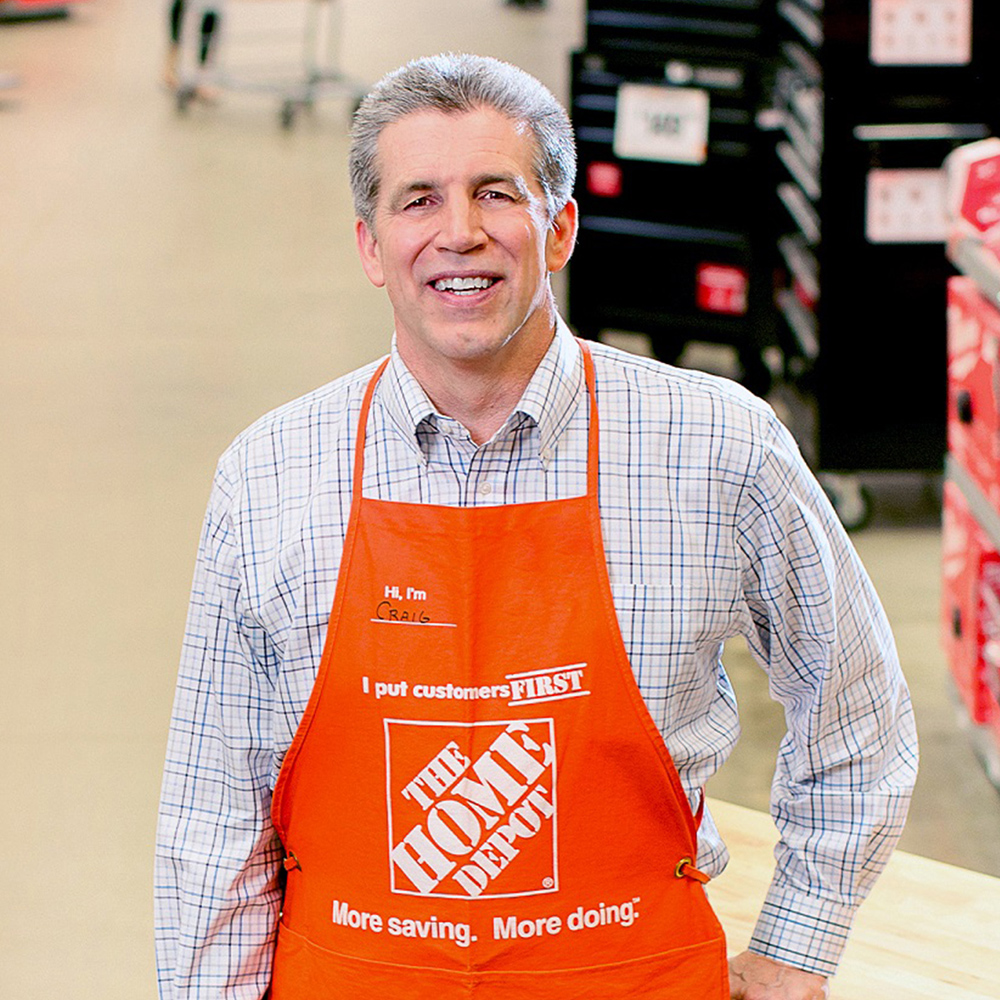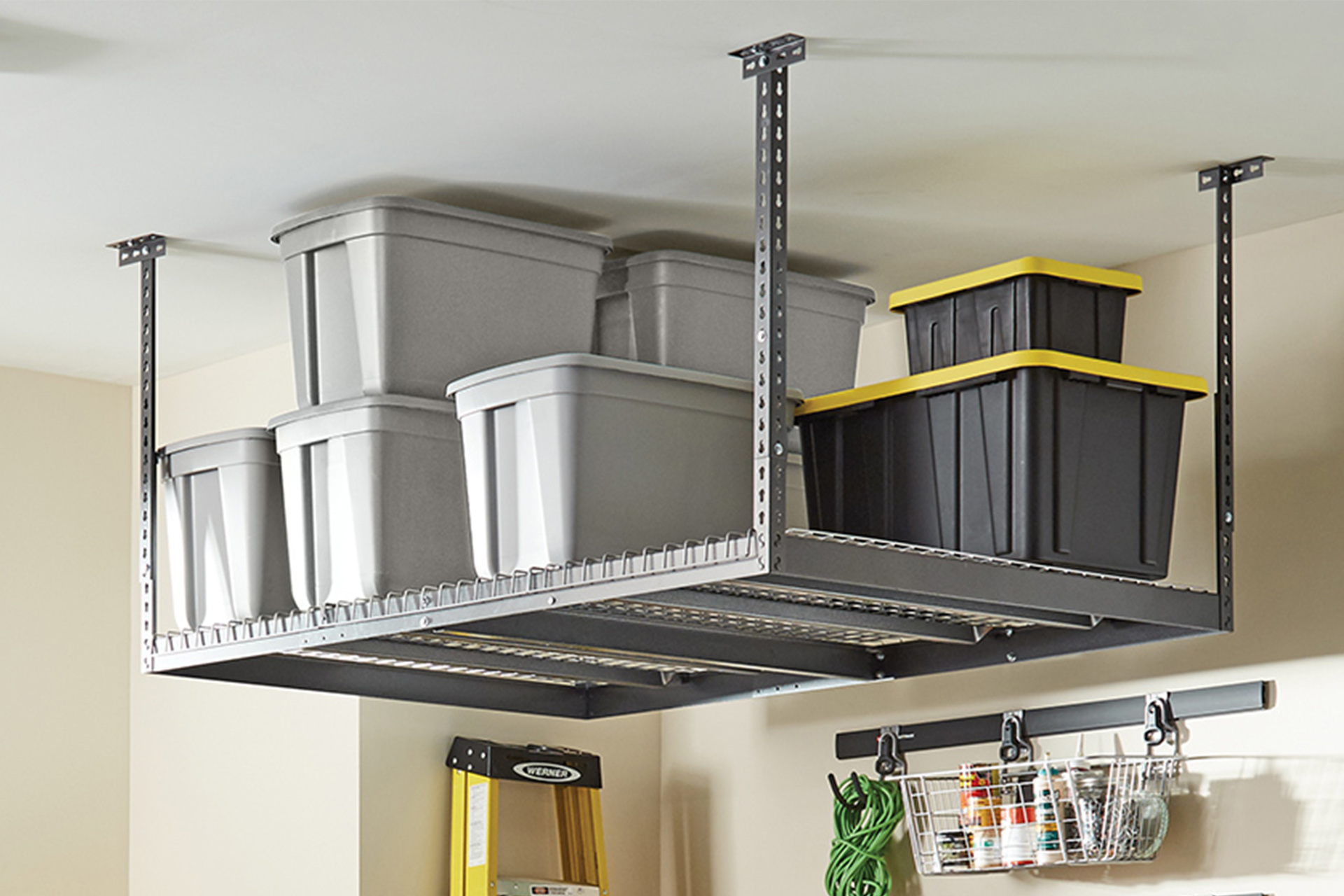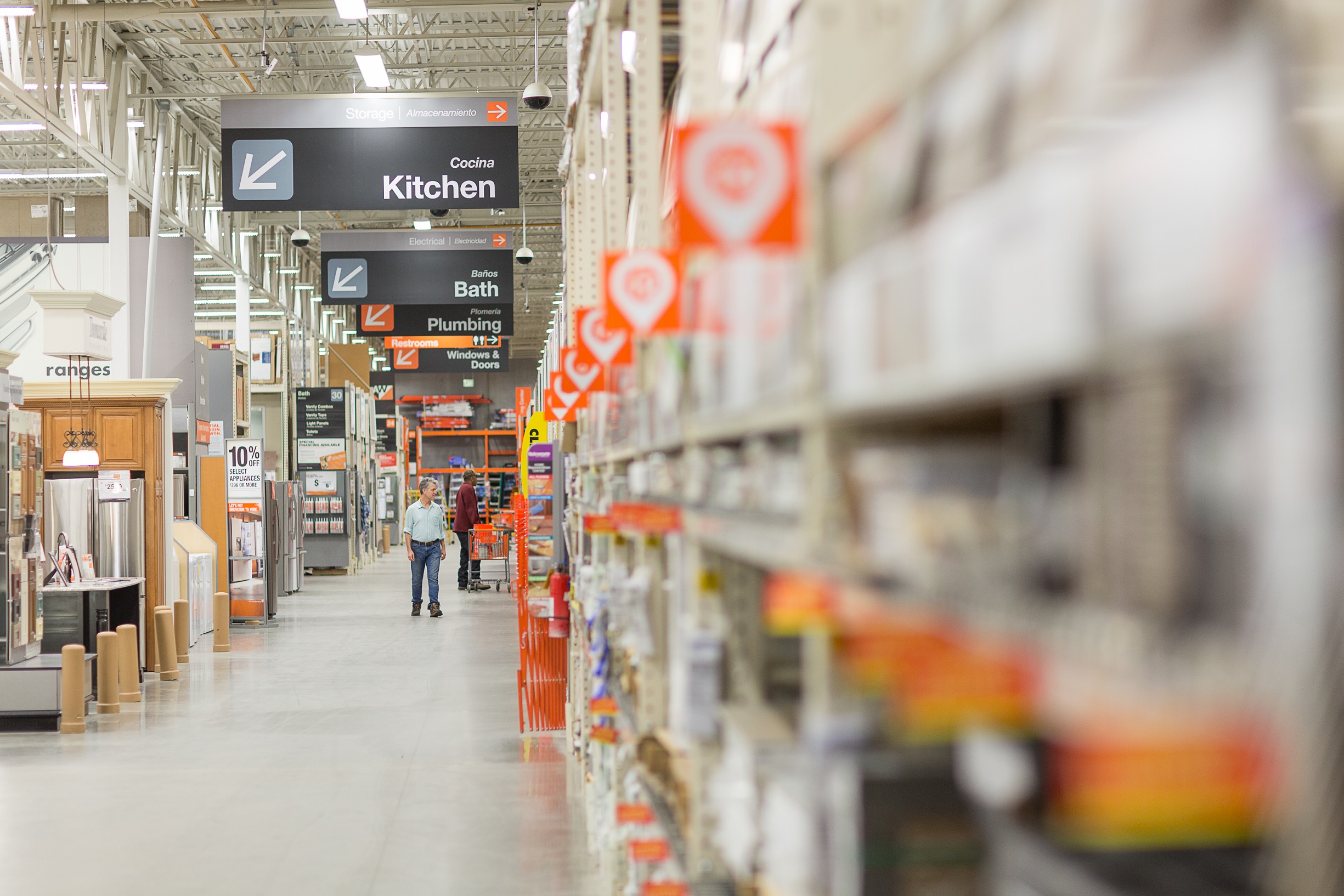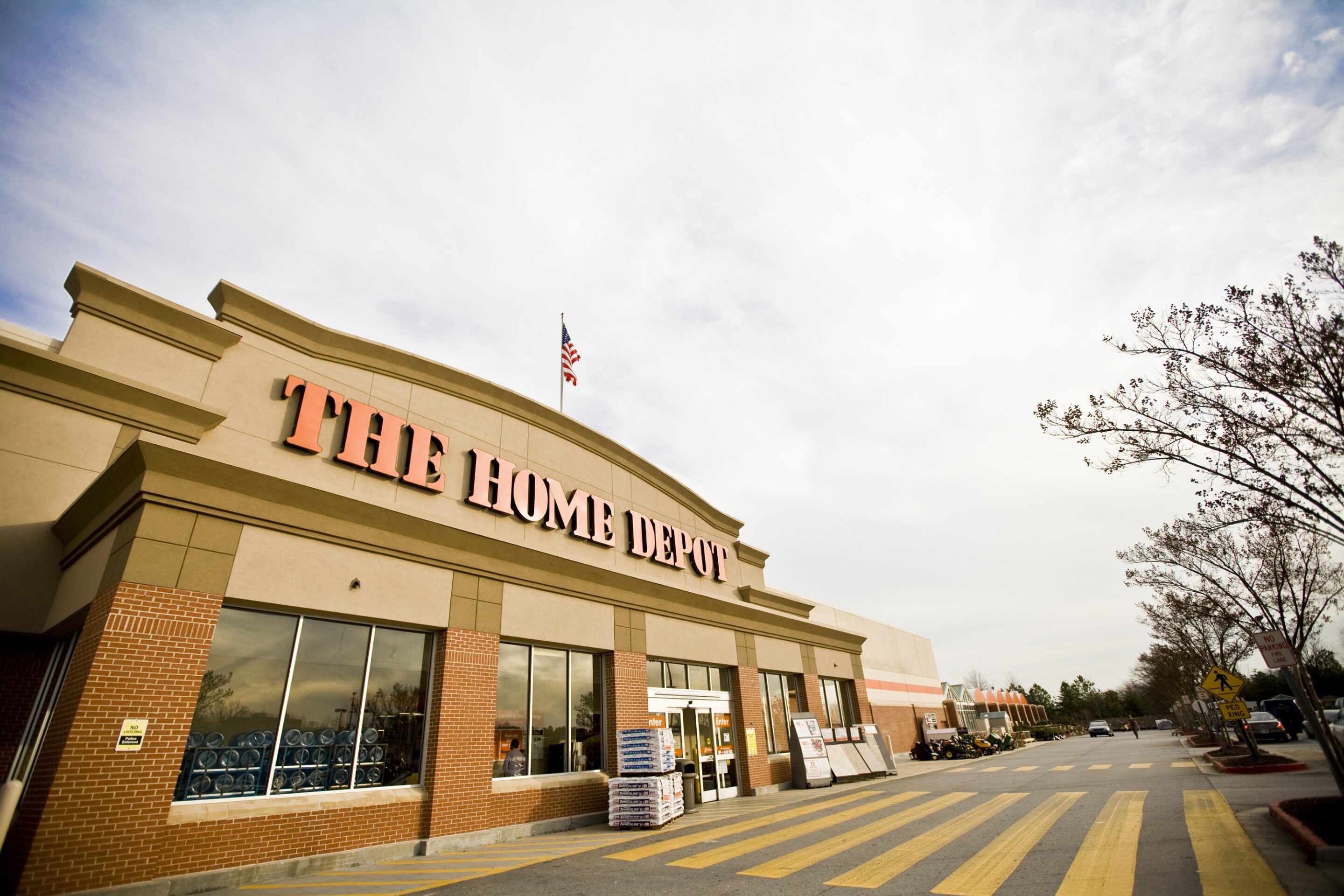This is the fourth installment of an exclusive HomePage News series examining the state of major home and housewares retailers entering the back half of 2021.
Read all installments of the HomePage News series: Big Retail Beyond 2021.
Home Depot is aligning to the new realities associated with the COVID-19 pandemic as the coronavirus influence slowly and unevenly winds down and the housing market shows signs of slowing.
Home Depot didn’t get a bump to its share price after posting stellar first-quarter numbers, with observers citing weak April housing numbers and the growing price of lumber.
Home Depot made significant gains in the second quarter compared with the period a year earlier when sales at its stores and website, both up and running amid shopping disruptions associated with the COVID-19 pandemic, got a boost based on the unique circumstances. For the 2021 second quarter, net earnings were $4.81 billion, or $4.53 per diluted share, compared with $4.33 billion, or $4.02 per diluted share, in the year-prior period. Sales increased 8.1% to $41.12 billion as comparable sales gained 4.5% and comps in the United States advanced 3.4% versus the quarter a year previous.
DIY Projects
Investors may have been a bit short sighted, however. Do-it-yourselfers can schedule projects around temporary price shifts in materials, for instance. Rising material costs may drive consumers, many of whom continue to stick close to home, to the kind of domestic projects they undertook in the Great Recession when money was tight but interest in painting, redecorating and home cooking became more prevalent to the benefit of the do-it-yourself sector.
A tighter housing market also can boost DIY projects that Home Depot supports, CEO Craig Menear said in a recent analyst meeting, as consumers decide to remodel existing households rather than shop for new dwellings.
A recent survey sponsored by DEWALT, a division of Stanley Black & Decker, found that home improvement demand should remain strong across the United States at least through the rest of 2021, with the tight housing market a driving factor. The study determined that 52% of homeowners across the United States are considering renovations as an alternative to buying a new home; and more than seven in 10 homeowners are already planning or considering a home renovation project.

Craig Menear, CEO, Home Depot
A tighter housing market also can boost DIY projects that Home Depot supports, CEO Craig Menear said in a recent analyst meeting, as consumers decide to remodel existing households rather than shop for new dwellings.
Younger Renovators
Younger homeowners are particularly looking at renovation projects, according to Bank of America’s 2021 Homebuyer Insights Report: Home Improvement and Equity Spotlight. An increasingly competitive home buying market and the aging of the nation’s housing inventory prompted two-thirds of younger homeowners surveyed for the report to say they plan to renovate this year. And they have the resources, with real home equity hanging around historic highs.
Bank of America emphasized that, with greater reliance on the household as a workplace, family haven and entertainment center, 71% of younger homeowners ages 18 to 43 have completed DIY work around their homes recently, compared to 42% of older homeowners ages 57 to 75, and 65% said they plan to renovate this year versus 22% of older homeowners.

The results suggest that younger consumers have developed a willingness and the skills to suit their homes to their lifestyles priorities. A little more than half of younger consumers said their relocations are about making the homestead more enjoyable, compared to 73% of older respondents who responded accordingly. Besides basic maintenance and improvements, 48% of younger consumers responding to the survey said they would renovate to add energy-efficient appliances, versus 36% of older consumers; while 51% of the younger group would renovate to add solar panels, versus 33% of the older. A high proportion of younger survey respondents, 44%, said they would rather buy fixer-uppers and improve them over time instead of fully renovated homes.
Repair & Remodel
In the Alliance Bernstein 37th Annual Strategic Decisions Conference, Menear said home building, even when it comes to smaller independent companies in the sector, isn’t a basic driver of the Home Depot business.
“New construction isn’t our game,” he said. “We’re much more repair, remodel.”
Although the company has a big professional business, he said that most of the purchasing at Home Depot stores is for renovation rather than scratch building work. Home Depot’s pro business has seen sequential growth from the second quarter of 2020 through the first quarter of 2021 as consumers became more comfortable having contractors come into their homes and municipalities ramped up permit granting.
-Craig Menear, CEO, Home Depot
“We really saw pro continue to progress, and in the first quarter of 2021, it was the first time since pre-pandemic that our pro business actually outgrew our DIY business. We were very pleased with the growth in both,” Menear said.
The company during the pandemic didn’t offer all the promotions it normally would, Menear noted, adding the retailer saw a big increase in low-margin appliances sales from consumers who decided to upgrade their home electrics.
Menear said even going back to the depths of the pandemic, the company’s services and other operations such as kitchen renovations that require contractor access to consumer homes began to improve. As such, he said, sales began to move toward a more normal balance over the latter half of 2020 and into 2021 as consumers became more comfortable in addressing pandemic risks.

Early Results
For the 2121 first quarter, Home Depot posted sales of $37.5 billion, up 32.7% from the first quarter of fiscal 2020. Comparable sales increased 31% in the period year over year, and comparable sales in the U.S. increased 29.9%. Company-wide diluted earnings per share were $3.86 versus $2.08 in the first quarter a year earlier.
Immediate market circumstances have played a part in Home Depot’s results, but longer-term issues also have had an influence. A critical issue that affected Home Depot operations is the Millennial generation’s move to the suburbs, another of those dynamics in place before but accelerated by the recession.
Millennials initially were expected to be a generation that wouldn’t become major DIYers as they confined to smaller living spaces. However, many younger former urbanites have trekked back to the ‘burbs.
Still, Millennials remain a hard demographic to pin down. In many cases, Millennials shrugged off the kind of luxury condos and apartments developers prepared for their return and instead purchased older housing that required some work but was often more affordable.
Marsha Everton, principal, corporate director and advisor, The AIMsights Group, a market research organization that has a Millennials specialty, said observers who don’t consider the pandemic-inspired acceleration of demographic trends as they’ve evolved during the coronavirus crisis are going to miss how much demographic trends favor home centers and hardware stores.
Suburban Millennials
Everton said Millennials have been moving to the suburbs for a variety of reasons, and among the most important and often underappreciated reasons is to reside near parents. Proximity to parents is something Millennials have sought given most mothers’ willingness to provide inexpensive or free childcare.
The flip side of that consideration is proximity gives Millennials the ability to keep an eye on aging parents. Millennial concern about parents is manifesting in multiple ways. Everton pointed out that home builders today are increasingly focused on constructing mother-daughter residences that include separate apartments.

AIMsights research points to home centers, with Home Depot obviously prominent, in a strong position with Millennials. Millennials are shifting spending priorities as they become older and care for families.
“They’ve gone from going to dinner out once a week to going to Home Depot once a week,” Everton said.
Still, she cautioned that post-pandemic spending shifts bear watching as consumers weigh their spending on home and more accessible extra-domestic activities.

Marsha Everton, Corporate Director & Advisor, AIMsights Group
Sustainable Growth
Certain initiatives suggest that Home Depot is pursuing opportunities with Millennials in new ways. For example, in April it announced the Company Conscious Collection, which the retailer characterizes as a line of environmentally friendly comforters and pillows. The collection emerges as an element in Home Depot’s ongoing commitment to providing sustainable products and incorporates blends of recycled and sustainably sourced materials.
The collection, consisting of bedding, represents a new way of addressing and further engaging younger shoppers most concerned about sustainability. However, it also is appropriate to targeting new customers who may not be environmentally focused but who aren’t settled in the shopping habits and remain open to purchasing non-DIY items from Home Depot.

Home Depot also is investing in online operations, which saw a 27% sales advance in the first quarter, to satisfy the demand for convenient engagement and to strengthen its relationship with younger consumers.
Although Millennial trends favor home centers and similar retailers, demographic-related prospects get even better from a broader perspective. AIMsights’ Everton said Baby Boomers are spending to make homes more accommodating of their golden years, in some cases moving but not necessarily downsizing in a significant way. They are moving into or modifying housing where they feel they can sustain independent lifestyles. Wherever they intend to age, Boomers are configuring households for the next phase of their lives. This is another development suggesting retailers who support home improvement and domestically focused lifestyles will continue to experience opportunity even after the pandemic fades as a market factor.
“It’s so important not to forget the Baby Boomers,” Everton said. “They are still the big spenders and they’ve been stuck at home. They’re the ones who put in the dream kitchen.”
Flexible Views
Everton added that any analysis of Home Depot that relies too much on housing market figures may be looking at its prospects too narrowly. Consumers who want to undertake home projects have flexibility given the scope of what they might initiate. So, Home Depot planter and hardscapes sales gained during the pandemic, and even as the immediate crisis has waned, the company noted in its first quarter conference call, and interior projects involving countertops, vanities, blinds and home decor have generated strong sales.
-Marsha Everton, Corporate Director & Advisor, AIMsights Group
In the company’s first-quarter conference call, Menear said, “We know that repair and remodel is the essence of what our business is all about. And then, of course, we’re there to help customers fulfill their dreams in terms of updating their homes. And clearly, over the last year, as customers have spent more time in their homes, they’ve told us that their home was never more important than it is today.”
Traffic Developments
Home centers and hardware stores in general entered the second quarter with relatively strong year over year store traffic, according to Placer.ai, with Home Depot up 21% in the first quarter and rivals Lowe’s and Ace Hardware up 22% and 21% respectively. The second quarter is to home/hardware channel what the end of year holidays are to the rest of retail, which bodes well for all involved. Ethan Chernofsky, Placer vp, marketing, stated that the year-over-year gains in the quarter should be taken in context.
As opposed to many retailers who suffered restrictions, home centers and hardware stores remained open as essential retailers and so could welcome customers who had plenty of enforced time off to work on their homes. In April, Home Depot enjoyed a 23.6% improvement in year over year store visits, Placer indicated, so strength there may be greater than some observers might believe. Then, taking out the extraordinary 2020 growth, Home Depot traffic still grew solidly as visitor counts gained 17.9% versus April 2019.

In addition, Home Depot continues to have substantial online growth, with eMarketer research indicating that the company’s 2021 digital revenue growth, at 18%, pacing just a bit higher than overall e-commerce market gain even as store visits saw the double-digit increase.
In his Strategic Decisions Conference presentation, Menear said predicting what is going to happen as the market unwinds from the pandemic and proceeds through 2022 is difficult as the usual economic touchstones have been scrambled by movement restrictions, shifting labor markets and the influence of government stimulus payments.
“There is so much uncertainty that it’s just really hard to understand in the near term where things might go, how customers will react as the economy opens back up, what will that mean for customer buying patterns,” Menear said. “Those are all big uncertainties. The historical measurements we disconnected from some time ago: clearly GDP was a key component and has been something you historically thought about in building your models. But as we saw last year, GDP went negative, you had massive unemployment but at the same time you had an influx of money, people’s bank accounts had never been better, their savings accounts are as high as they’d been since the ‘70s. And we saw tremendous demand.”
There is so much uncertainty that it’s just really hard to understand in the near term where things might go, how customers will react as the economy opens back up, what will that mean for the customer buying patterns.
-Craig Menear, CEO, Home Depot
Now, Menear continued, expanding home ownership and the housing shortage will continue to encourage consumers to engage in home projects, whether personally or professionally undertaken.
So, Menear said, “When we look at the big picture environment longer term for home improvement, we feel it’s very, very solid. The longer-term outlook from a housing standpoint in home ownership by the Millennial generation, their engagement in home improvement, home value appreciation partially driven by a post-World War II shortage of housing that exists in this country, aging household base in the U.S…. point to a solid environment for home improvement for the longer haul. It’s just the uncertainty that exists in the near term. We can’t predict that. What we’ve learned is for us to be agile and flexible and be able to deal with whatever gets thrown our way is what’s most important in the environment we live in today.”





